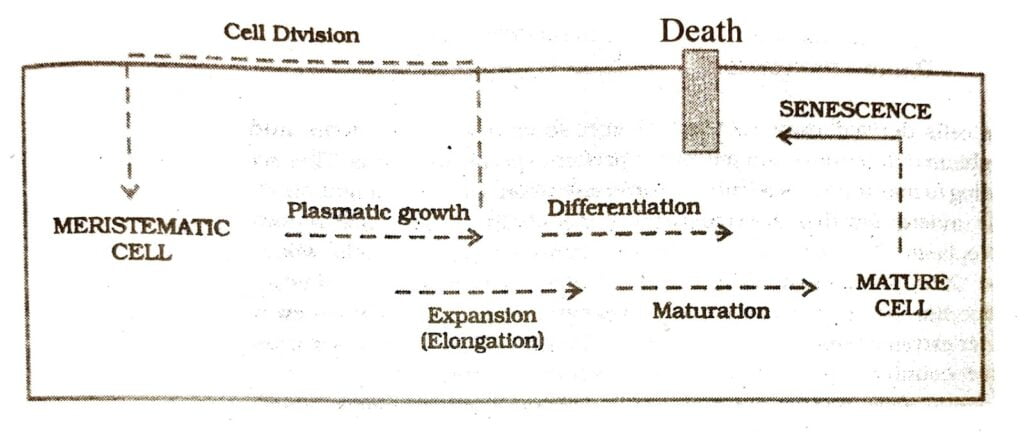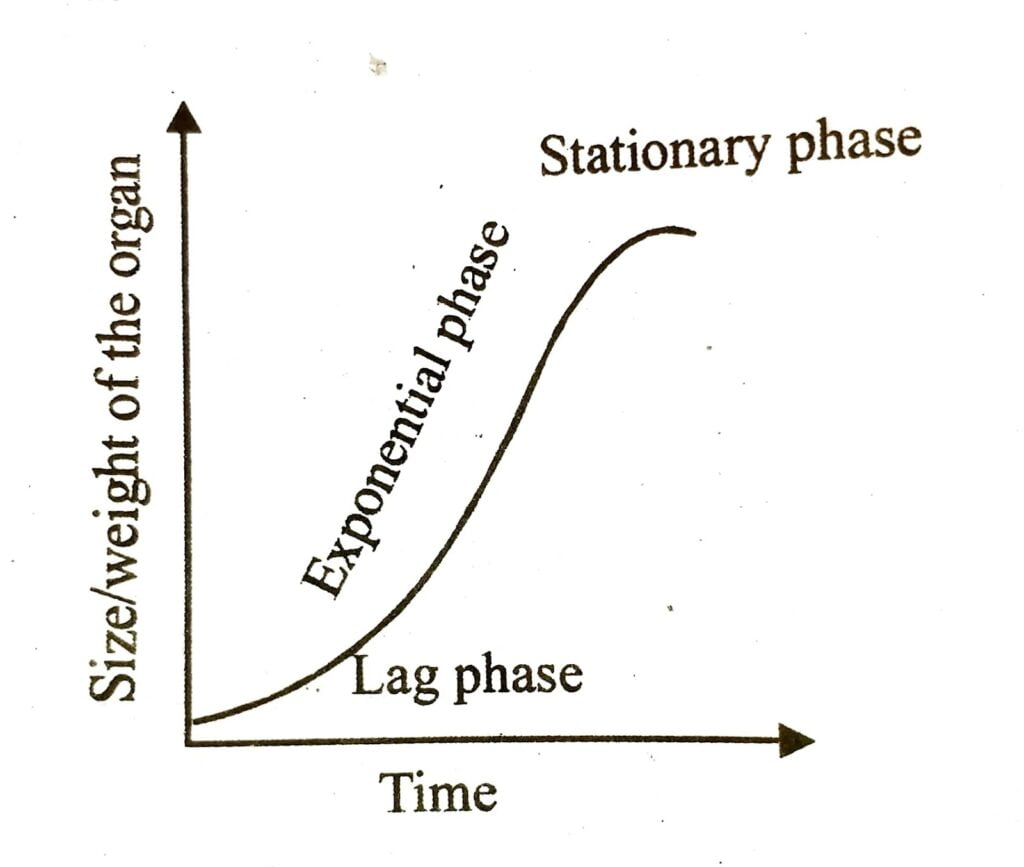Class 11 Biology Chapter 15 Plant Growth and Development, AHSEC Class 11 Biology Question Answer, HS 1st year Biology notes to each chapter are provided in the list so that you can easily browse throughout different chapters Assam Board Class 11 Biology Chapter 15 Plant Growth and Development Question Answer and select needs one.
Class 11 Biology Chapter 15 Plant Growth and Development
Also, you can read the SCERT book online in these sections Solutions by Expert Teachers as per SCERT (CBSE) Book guidelines. These solutions are part of SCERT All Subject Solutions. Here we have given Assam Board Class 11 Biology Chapter 15 Plant Growth and Development Solutions for All Subjects, You can practice these here.
Plant Growth and Development
Chapter – 15
VERY SHORT ANSWER TYPE QUESTIONS
Q.1. Define growth?
Ans :- Growth is defined as an irreversible permanent increase in size of an organ or its parts or even of an individual call.
Q.2. Why is plants growth considered unique?
Ans :- Plants growth is considered unique because plants retain the capacity of unlimited growth through out their life.
Q.3. What is open form of growth?
Ans :- The form of growth wherein new cells are always being added to the plant body by the activity of the meristem is called open form of growth.
Q.4. Name the meristem responsible for primary growth?
Ans :- Root apical meristem and shoot apical meristem are responsible for the primary growth of plants.
Q.5. Name the meristem responsible for the increase in the girth of organs.
Ans :- Lateral meristem, vascular cambium and cork cambium are responsible for the increase in the girth of organs.
Q.6. What are the promontories by which growth is measured?
Ans :- The parameters by which growth is measured are increase in fresh weight, dry weight, length, area, volume and cell number.
Q.7. Name the phases in the period of growth of plant.
Ans :- The phases in the period of growth of plant are meristematic, elongation and maturation phase.
Q.8. What is growth rate?
Ans :- The increased growth per unit time is called growth rate.
Q.9. What is arithmetic growth?
Ans :- In arithmetic growth, following mitotic cell division only one daughter cell continues to divide while the other differentiates and matures.
Q.10. Express arithmetic growth mathematically.
Ans :- Lₜ = L₀ + rt
Lₜ = Length at time t.
L₀ = Length at time Zero.
r = Growth rate.
Q.11. What is a sigmoid curve?
Ans :- A sigmoid curve is a characteristic of living organism growing in a natural environment.
Q.12. What is differentiation?
Ans :- The cells derived from root apical and shoot apical meristem. and cambium differentiate and mature to perform specific functions. This act leading to maturation is called differentiation.
Q.13. What is dedifferentiation?
Ans :- The phenomenon of regaining the capacity of division in the cells which have lost this power is called dedifferentiate.
Q.14. What is the meaning of development?
Ans :- Development is a term that includes all changes that an organism goes through during its life cycle from germination of seed to senescence.
Q.15. What is plasticity?
Ans :- The ability of the plant to respond to environment to form different kind of structure is called plasticity.
Q.16. What are plant growth regulator (PGR)?
Ans :- The plant growth regulator are small, simple molecules of diverse chemical composition.
Q.17. Write the name of a few PGR.
Ans :- Indole-3 acetic acid IAA, abscisic acid, gibberellic acid (GA₃) etc.
Q.18. What is the other name of plant growth regulator?
Ans :- The other name of plant growth regulator are plant hormones or phytohormones.
Q.19. Name the phytohormones which are also called plant growth promoters.
Ans :- Auxins, gibberellins and cytokinin are also called plant growth promoters.
Q.20. Who discovered the plant growth regulator?
Ans :- Charles Darwin and his son Francis Darwin discovered plant growth regulator.
Q.21. Name the phytohormone isolated from the tips of coleoptile of oat seedling.
Ans :- Auxin.
Q.22. Name the pathogen responsible for the disease ‘bakane’ or foolish seedling.
Ans :- A fungal pathogen named Gibberella fujikuroi is responsible for ‘bakanae’ disease.
Q.23. Name the different kinds of inhibitors.
Ans :- Inhibitor-B, abscission II and dormin are the different kinds of inhibitors.
Q.24. From where was auxin first isolated?
Ans :- Auxin was first isolated from human urine.
Q.25. Where are auxins produced in a plant?
Ans :- Auxins are produced at the growing apices of stems and roots.
Q.26. Name two synthetic auxins.
Ans :- The synthetic auxins are Naphthalene acetic acid and 2, 4-Dichlorophenoxyacetic. acid.
Q.27. What is apical dominance?
Ans :- In higher plants, the growing apical bud inhibit the growth of lateral buds. This phenomenon is called apical dominance.
Q.28. Which is the most widely used compound of ethylene?
Ans :- The most widely used compound of ethylene is ethephon.
Q.29. Why is abscisic acid called stress hormone?
Ans :- Abscisic acid is called stress hormone because it increases the tolerance of plants to various kinds of stress.
Q.30. What are long day plants?
Ans :- The plants which require exposure to light for a period exceeding the critical duration are called long day plants.
Q.31. What are short day plants?
Ans :- The plants which require exposure to light for a period lesser than the critical duration are called short day plants.
Q.32. What is photoperiodism?
Ans :- The response of plants to periods of day/night is called photoperiodism..
Q.33. What is the site of perception of light/dark duration?
Ans :- The site of perception of light/dark duration are the leaves.
Q.34. What is vernalization?
Ans :- The phenomenon of hastening flowering late in plants at low temperature is called vernalization.
Q.35. What type of plants show vernalization?
Ans :- Biennial plants mostly show vernalization.
Read Also: Abnormal Blood Pressure – Symptoms, Causes and Remedies
SHORT ANSWER TYPE QUESTIONS
Q.1. Why is plant growth said to be indeterminate?
Ans :- Plant growth is unique because plants retain the capacity for unlimited growth throughout their life. This ability of the plant is due to the presence of meristem at certain locations in their body, the cells of such meristem have the capacity to divide and self perpetuate. Hence plant growth is said to be indeterminate.
Q.2. What do you mean by secondary growth of a plant?
Ans :- In dicotyledonous plants and gymnosperms., the lateral meristem, vascular cambium and cork-cambium appear late in life. These are the meristems that causes the increase in the girth of the organs in which they are active. This is known as secondary growth of the plant.
Q.3. Write a note on meristematic phase of growth.
Ans :- The constantly dividing cells, both at the root apex and shoot apex represent the meristematic phase of growth. The cells in this region are rich in protoplasm, possess large conspicuous nuclei their cell wall are thin and cellulosic with plasmodesmatal connections.
Q.4. Write the characteristics of elongation phase and maturation phase.
Ans :- The cells proximal to the meristematic zone is the phase of elongation. Increase vacuolation, cell enlargement and new cell wall depositions are the main characteristics of the cells in this phase.
Away from the apex, more proximal to the phase of elongation, lies the phase of maturation. The cells of this zone, attain their maximum size in terms of wall thickening and protoplasmic modification.
Q.5. What are the necessary conditions for growth?
Ans :- The plant cells grow in size by cell enlargement which in turn requires water Turgidity of cells help in extension growth. Water also provide the medium for enzymatic activities needed for growth. Oxygen helps in releasing metabolic energy essential for growth. Nutrients are required by plants for the synthesis of protoplasm. In addition every plant has an optimum temperature range for its growth.
Q.6. What is redifferentiation?
Ans :- The living differentiated cells that by now have lost the capacity to divide can regain the capacity of division. This is known as dedifferentiation. While doing so some meristem or tissue formed again lose the capacity to divide but mature to perform specific function. This ph enomenon is called redifferentiation.
Q.7. Why is differentiation in plants said to be ‘open’?
Ans :- The differentiation in plants is said to be open because cells/tissues arising out of the same meristems have different structures at maturity. For example, cells positioned away from root apical meristem differentiate as root-cap cells, while those pushed to periphery mature as epidermis.
Q.8. Diagrammatically represent the sequence of process in development of a cell.
Ans :-

Q.9. Explain with an example the phenomenon of plasticity.
Ans :- Plants follow different pathway in response to environment to form different kind of structures. This ability is called plasticity. e.g. heterophylly in cotton, coriander and larkspur. In such plants the leaves of juvenile plants.
Q.10. List five main groups of natural plant growth regulator.
Ans :- The five main groups of natural plant growth regulator are :
i) Indole compounds (indole-3 acetic acid, IAA)
ii) Adenine deviation (kinetin)
iii) Derivative of carotenoids (ABA)
iv) Terpenes (gibberellic acid)
v) Gases (ethylene)
Q.11. Write the main functions of plant growth regulators.
Ans :- The main function of plant growth regulator are
i) Cell division, cell enlargement.
ii) Flowering, fruiting and seed formation.
iii) Response to wounds and stresses of biotic and abiotic origin.
iv) Dormancy and abscission.
Q.12. How was auxin discovered?
Ans :- Charles Darwin and his son Francis Darwin they observed that the coleoptile of canary grass responded to unilateral illumination by growing towards the light source during experimental studies. After a series of experiment, it was concluded that the tip of coleoptile was the site of transmittable influence that caused the bending of coleoptile. The phytohormone discovered from the coleoptile was ‘auxin’. It was isolated by F.W. went.
Q.13. How was bakanae disease caused? Explain.
Ans :- The bakane (Foolish seedling) a disease of rice seedling was caused by a fungal pathogen Gibberella fujikuroi. E. Kurosawa reported the appearance of symptoms of the disease in uninfected rice seedling when they were treated with sterile filtrate of the fungus. The active substance was later identified as gibberellic acid.
Q.14. How was kinetin discovered?
Ans :- F. Stooge and his co-workers observed that from the internodal segment of tobacco stems the callus (a mass of undifferentiated cells) proliferated only, if, in addition to auxin the nutrient medium was supplemented with one of the following : extract of vascular tissue, yeast extract, coconut milk or DNA.
Skoog and miller, later identified and crystallised the cytokinesis promoting active substance and called them ‘kinetin’.
Q.15. Write the main functions of ethylene.
Ans :- The main function of ethylene are:
i) It promotes senescence and accusations of plant organs especially of leaves and flowers.
ii) It is highly effective in fruit ripening.
iii) It enhances the respiratory rate during ripening of fruits.
iv) It breaks seed and bud dormancy.
Q.16. Write a note on ethephon.
Ans :- The most widely used compound as a source of ethylene is ethephon. Ethephon in an aqueous solution is readily absorbed and transported within the plant and releases ethylene slowly. Ethephon hastens fruit ripening in tomatoes and apples and accelerates abscission in flowers and fruits.
LONG ANSWER TYPE QUESTIONS
Q.1. Describe briefly:
a) Arithmetic growth.
b) Geometric growth.
c) Sigmoid growth curve.
d) Absolute and relative growth rate.
And :- a) Arithmetic growth: In arithmetic growth, following mitotic cell division, only one daughter cell continues to divide while the other differentiates and mature. The simplest expression of arithmetic growth is exemplified by a root elongating at a constant rate.
Mathematically it is expressed as
Lₜ = L₀ + rt
Lₜ = length at time t.
L₀ = length at the time zero.
r = growth rate/elongation per unit time.
b) Geometric growth: In geometric growth, the initial growth is slow (lag phase) and it increases rapidly thereafter, at an exponential rate (log phase). Here both the progeny cells following mitotic cell division retain the ability to divide and continue to do so.

c) Sigmoid curve: After the lag and log phase, with limited nutrient supply, the growth slows down leading to a stationary phase. If we plot a parameter of growth against me, we get a typical curve which is in the form of ‘S’ and is called sigmoid curve.
A sigmoid curve is a characteristics of living organism growing a natural environment.

d) Absolute and relative growth rate: The quantitative comparison between the growth of living system can also be made in 2 ways.
i) The measurement and comparison of total growth per unit time are called absolute growth rate.
ii) The growth of given system per unit time expressed on a common basis e.g. per unit initial parameter is called relative growth rate.

Q.2. Write an account on auxins.
Ans :- The word ‘auxin’ (a Greek word) means to grow, was first isolated from human urine.
Auxin are generally produced by the growing apices of the stem, and roots, from where they migrate to the region of their action. Indole acetic acid and Indole, butyric acid are isolated from plants Naphthalene acitic acid and 2, 4-D are synthetic auxins Auxins are used extensively in agricultural and horticultural practices.
Auxins initiate rooting in stem cutting, promotes flowering e.g in pineapples. They help to prevent fruit and leaf drop at early stages but promote abscission of older mature leaves and fruits Auxin induces parthenocarpy e.g in tomatoes. They are widely used as herbicides. 2, 4-D is widely used to kill dicotyledonous weeds. It is used to prepare weed-free lawns by gardeners. Auxin also control xylem differentiation and helps in cell division.
Q.3. What are the major functions of gibberellins and cytokinins.
Ans :- Gibberellins are denoted as GA1, GA2, and GA3. Gibberellic acid was one of the first gibberellins to be discovered. All gibberellic acid are acidic.
The main function of gibberellins are:
i) Their ability to cause an increase in length of axis.
ii) Gibberellins causes fruit like apple to elongate and improve its shape.
iii) They also delay senescence. Thus the fruit can be left on the free longer so as to extend the market period.
iv) GA3 is used to speed up the matting process in brewing industry.
v) Spraying juvenile conifers with GA hastens the maturity period, thus leading to early seed production.
Cytokinins:
Cytokinins were discovered as kinetin from the autoclaved herring sperm DNA.
The main function of cytokinin are:
i) It helps to produce new leaves, chloroplast in leaves, lateral shoot growth and adventitious shoot formation.
ii) It helps to overcome apical dominance.
iii) It promotes nutrient mobilisation which helps in the delay of leaf senescence.
Q.4. Write a short note on.
a) Ethylene.
b) Abscisic acid.
Ans :- a) Ethylene is a simple gaseous plant growth regulation. It is synthesised in large amount by tissue undergoing senescence and ripening fruits. Ethylene induces horizontal growth of seedling, swelling of the axis and apical hook formation in dicot seedling.
Ethylene promote abscision of plant organs especially of leaves and flowers. It is highly effective in fruit ripening. It enhances the respiration rate during ripening of fruits. This rise in rate of respirations called respiratory climactic.
Ethylene breaks seed and bud dormancy. It promoter rapid internode/petiole elongation in deep water rice plants. Ethylene promotes root growth and root hair formation, thus helping the plants to increase their absorption surface.
Since ethylene regulates os many physiological process, it is one of the most widely used PGR in agriculture. The most widely used compound as a source of ethylene is ethephon.
b) Abscisic acid (ABA):
Abscisic acid was discovered for its role in regulating abscission and dormancy.
i) It acts as a general plant growth inhibitor and an inhibitor of plant metabolism.
ii) ABA inhibits seed germination.
iii) It stimulates the closure of stomata in the epidermis and increases the tolerance of plants to various kinds of stresses.
iv) ABA plays an important role in seed development, maturation and dormancy.
Q.5. What do you mean by photoperiodism and verbalization? Describe their significance.
Ans :- Some plants require a periodic exposure to light to for a period exceeding a well defined critical duration, while others must be exposed to light for a period less than this critical duration before the flowering is initiated in them. The former group are called long day plants while the latter ones are termed short day plants, where there is no such correlation between exposure to light duration and induction of flowering response, such plants are called day-neutral plants. Hence it can be said that flowering in certain plants depend not only on a combination of light and dark period of day/ night is termed as photo periodism.
Verbalization: There are plants for which flowering is either quantitatively or qualitatively dependent on exposure to low temperature. This phenomenon is known as verbalization.
It prevents precocious reproductive development late in growing season and enables the plant to have sufficient time to reach maturity. It refers to the promotion of flowering by a period of low temperature.
One example of verbalization is seen in biennial plants. Biennial are monocarpic plant that normally flower and die in second season. Sugarbeet, cabbage and carrots are some common biennials. Subjecting the growing of a biennial plant to cold treatment stimulates a subsequent phot periodic flowering response.

Hi, I’m Dev Kirtonia, Founder & CEO of Dev Library. A website that provides all SCERT, NCERT 3 to 12, and BA, B.com, B.Sc, and Computer Science with Post Graduate Notes & Suggestions, Novel, eBooks, Biography, Quotes, Study Materials, and more.




